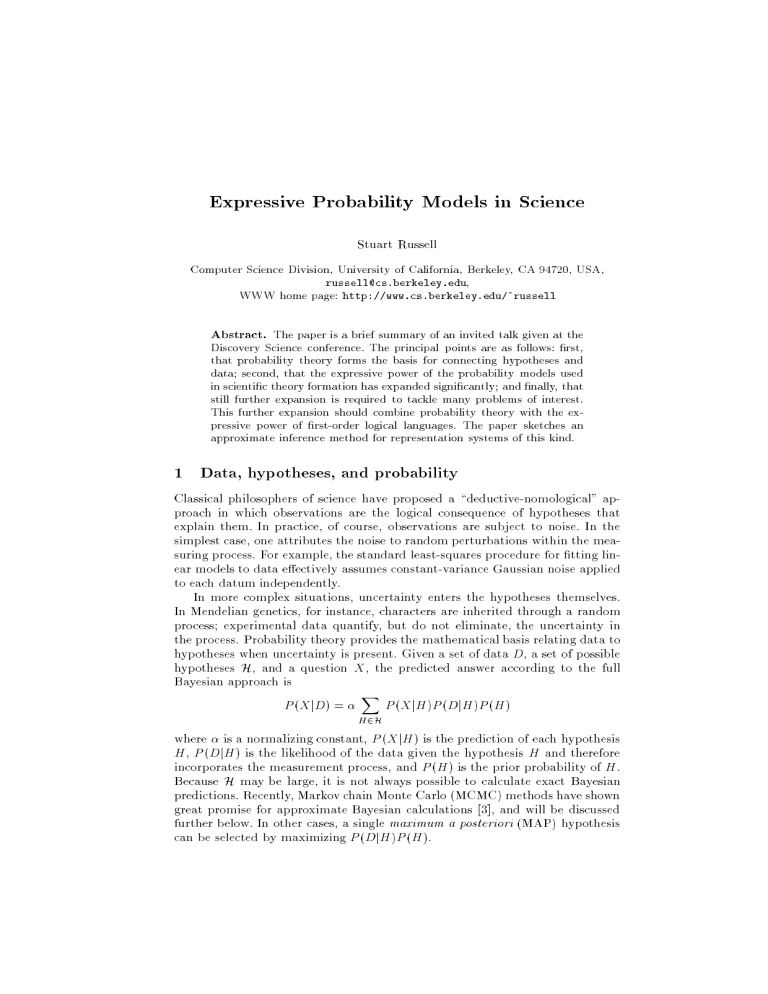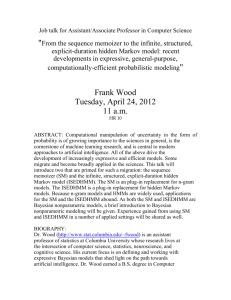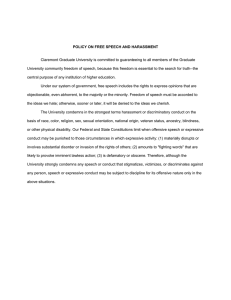
Expressive Probability Models in Science
Stuart Russell
Computer Science Division, University of California, Berkeley, CA 94720, USA,
russell@cs.berkeley.edu,
WWW home page: http://www.cs.berkeley.edu/~russell
Abstract. The paper is a brief summary of an invited talk given at the
Discovery Science conference. The principal points are as follows: rst,
that probability theory forms the basis for connecting hypotheses and
data; second, that the expressive power of the probability models used
in scienti c theory formation has expanded signi cantly; and nally, that
still further expansion is required to tackle many problems of interest.
This further expansion should combine probability theory with the expressive power of rst-order logical languages. The paper sketches an
approximate inference method for representation systems of this kind.
1
Data, hypotheses, and probability
Classical philosophers of science have proposed a \deductive-nomological" approach in which observations are the logical consequence of hypotheses that
explain them. In practice, of course, observations are subject to noise. In the
simplest case, one attributes the noise to random perturbations within the measuring process. For example, the standard least-squares procedure for tting linear models to data e ectively assumes constant-variance Gaussian noise applied
to each datum independently.
In more complex situations, uncertainty enters the hypotheses themselves.
In Mendelian genetics, for instance, characters are inherited through a random
process; experimental data quantify, but do not eliminate, the uncertainty in
the process. Probability theory provides the mathematical basis relating data to
hypotheses when uncertainty is present. Given a set of data D, a set of possible
hypotheses H, and a question X , the predicted answer according to the full
Bayesian approach is
P (X jD) =
P (X jH )P (DjH )P (H )
X
H 2H
where is a normalizing constant, P (X jH ) is the prediction of each hypothesis
H , P (DjH ) is the likelihood of the data given the hypothesis H and therefore
incorporates the measurement process, and P (H ) is the prior probability of H .
Because H may be large, it is not always possible to calculate exact Bayesian
predictions. Recently, Markov chain Monte Carlo (MCMC) methods have shown
great promise for approximate Bayesian calculations [3], and will be discussed
further below. In other cases, a single maximum a posteriori (MAP) hypothesis
can be selected by maximizing P (DjH )P (H ).
2
Expressive power
Probability models (hypotheses) typically specify probability distributions over
\events." Roughly speaking, a model family L2 is at least as expressive as L1 i ,
for every e1 in L1, there is some e2 in L2 such that e1 and e2 denote \the same"
distribution. Crude expressive power in this sense is obviously important, but
more important is ecient representation: we prefer desirable distributions to
be represented by subfamilies with \fewer parameters," enabling faster learning.
The simplest probability model is the \atomic" distribution that speci es
a probability explicitly for each event. Bayesian networks, generalized linear
models, and, to some extent, neural networks provide compact descriptions of
multivariate distributions. These models are all analogues of propositional logic
representations.
Additional expressive power is needed to represent temporal processes: hidden Markov models (HMMs) are atomic temporal models, whereas Kalman lters and dynamic Bayesian networks (DBNs) are multivariate temporal models.
The eciency advantage of multivariate over atomic models is clearly seen with
DBNs and HMMs: while the two families are equally expressive, a DBN representing a sparse process with n bits of state information requires O(n) parameters
whereas the equivalent HMM requires O(2n). This appears to result in greater
statistical eciency and hence better performance for DBNs in speech recognition [10]. DBNs also seem promising for biological modelling in areas such as
oncogenesis [2] and genetic networks.
In areas where still more complex models are required, there has been less
progress in creating general-purpose representation languages. Estimating the
amount of dark matter in the galaxy by counting rare MACHO observations [9]
required a detailed statistical model of matter distribution, observation regime,
and instrument eciency; no general tools are available that can handle this kind
of aggregate modelling. Research on phylogenetic trees [1] and genetic linkage
analysis [8] uses models with repeating parameter patterns and di erent tree
structures for each data set; again, only special-purpose algorithms are used.
What is missing from standard tools is the ability to handle distributions over attributes and relations of multiple objects|the province of rst-order languages.
3
First-order languages
First-order probabilistic logics (FOPL) knowledge bases specify probability distributions over events that are models of the rst-order language [5]. The ability
to handle objects and relations gives such languages a huge advantage in representational eciency in certain situations: for example, the rules of chess can be
written in about one page of Prolog but require perhaps millions of pages in a
propositional language. Recent work by Koller and Pfe er [6] has succeeded in
devising restricted sublanguages that make it relatively easy to specify complete
distributions over events (see also [7]). Current inference methods, however, are
somewhat restricted in their ability to handle uncertainty in the relational structure of the domain or in the number of objects it contains. It is possible that
algorithms based on MCMC will yield more exibility. The basic idea is to construct a Markov chain on the set of logical models of the FOPL theory. In each
model, any query can be answered simply; the MCMC method samples models
so that estimates of the query probability converge to the true posterior. For
example, suppose we have the following simple knowledge base:
8x; y P (CoveredBy(x; y)) = 0:3
8x P (Safe(x) j 9y CoveredBy(x; y)) = 0:8
8x P (Safe(x) j :9y CoveredBy(x; y)) = 0:5
and we want to know the probability that everyone who is safe is covered only
by safe people, given certain data on objects a, b, c, d:
P (8x Safe(x) ) (8y CoveredBy(x; y) ) Safe(y)) j Safe(a); Safe(b); :Safe(d))
Figure 1 shows the results of running MCMC for this query.
0.5
0.45
0.4
Probability
0.35
0.3
0.25
0.2
0.15
0.1
0.05
0
16
64
256
1024
No of samples
4096
Fig.1. Solution of a rst-order query by MCMC, showing the average probability over
10 runs as a function of sample size (solid line)
Much work remains to be done, including convergence proofs for MCMC on
in nite model spaces, analyses of the complexity of approximate inference for
various sublanguages, and incremental query answering between models. The
approach has much in common with the general pattern theory of Grenander [4],
but should bene t from the vast research base dealing with representation, inference, and learning in rst-order logic.
References
1. J. Felsenstein. Inferring phylogenies from protein sequences by parsimony, distance,
and likelihood methods. Methods in Enzymology, 266:418{427, 1996.
2. Nir Friedman, Kevin Murphy, and Stuart Russell. Learning the structure of dynamic probabilistic networks. In Uncertainty in Arti cial Intelligence: Proceedings
of the Fourteenth Conference, Madison, Wisconsin, July 1998. Morgan Kaufmann.
3. W.R. Gilks, S. Richardson, and D.J. Spiegelhalter, editors. Markov chain Monte
Carlo in practice. Chapman and Hall, London, 1996.
4. Ulf Grenander. General pattern theory. Oxford University Press, Oxford, 1993.
5. J. Y. Halpern. An analysis of rst-order logics of probability. Arti cial Intelligence,
46(3):311{350, 1990.
6. D. Koller and A. Pfe er. Probabilistic frame-based systems. In Proceedings of
the Fifteenth National Conference on Arti cial Intelligence (AAAI-98), Madison,
Wisconsin, July 1998. AAAI Press.
7. S. Muggleton. Stochastic logic programs. Journal of Logic Programming, to appear,
1999.
8. M. Polymeropoulos, J. Higgins, L. Golbe, et al. Mapping of a gene for Parkinson's
disease to chromosome 4q21-q23. Science, 274(5290):1197{1199, 1996.
9. W. Sutherland. Gravitational microlensing: A report on the MACHO project.
Reviews of Modern Physics, 71:421{434, January 1999.
10. Geo Zweig and Stuart J. Russell. Speech recognition with dynamic Bayesian networks. In Proceedings of the Fifteenth National Conference on Arti cial Intelligence
(AAAI-98), Madison, Wisconsin, July 1998. AAAI Press.


